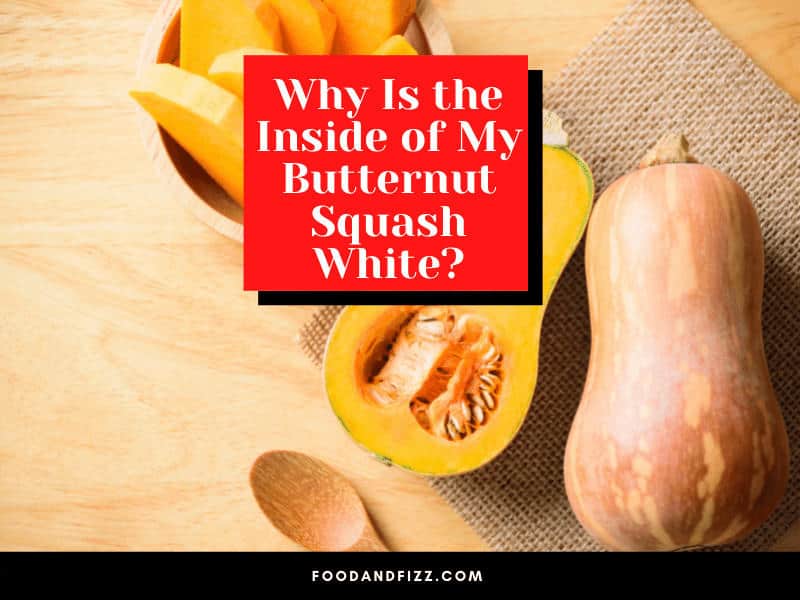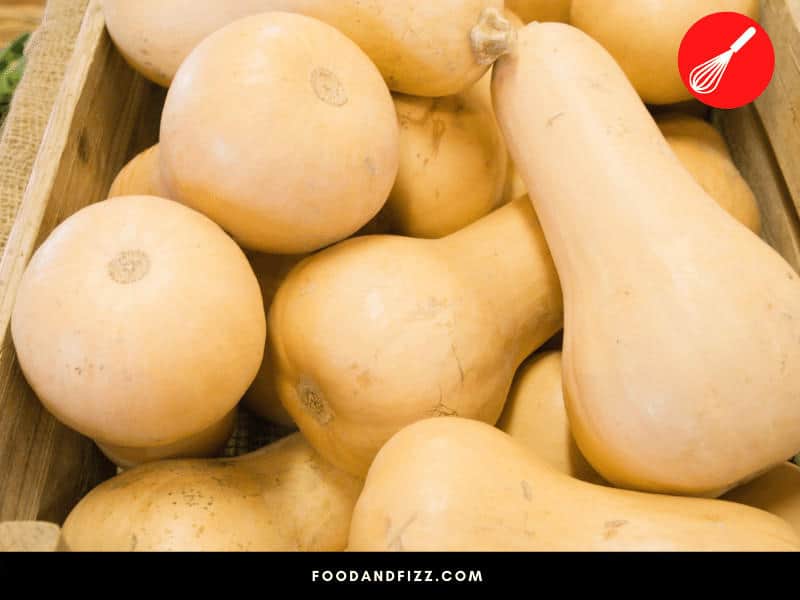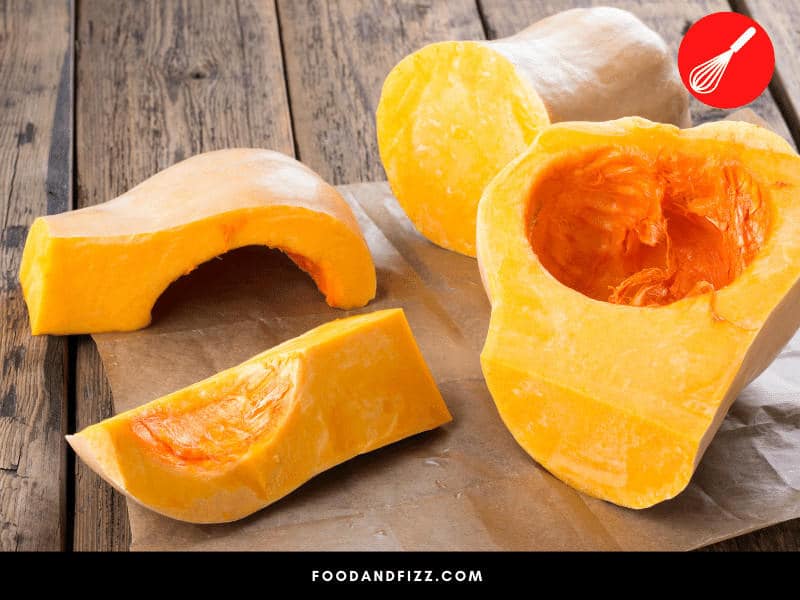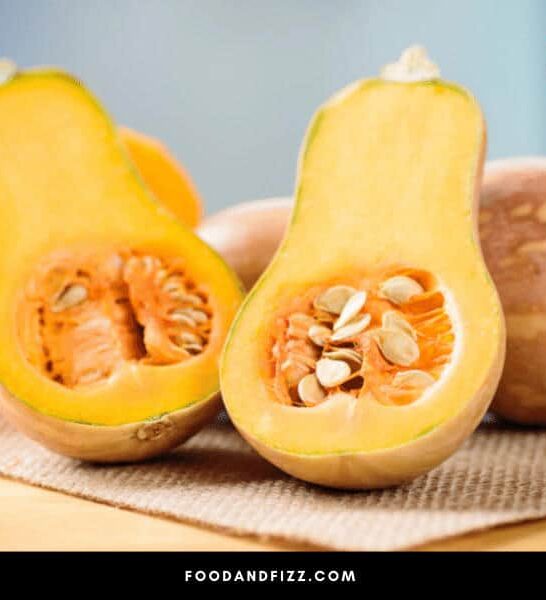Butternut squash is beloved for its natural sweetness and earthiness.
The University of Illinois calls butternut squash one of the favorite winter squashes.
Chefs and home cooks take advantage of butternut squash’s distinctive flavor by roasting it, sautéing it, or pureeing it before adding it to the soup.
While preparing butternut squash for dinner, you may find some kind of white substance inside of it. Is the butternut squash still safe to eat at that point? Find out by reading the rest of this article.
Butternut Squash White Inside
The white substance found inside butternut squash can be one of two things. White spots appearing on the flesh or rind of the butternut squash are indicators that the fruit has gone bad. The butternut squash is no longer safe to eat at that point. A white liquid oozing out of the butternut squash is some kind of sugar substance. Despite what the sugar substance looks like, it is safe to eat along with the rest of the squash.

What Are the White Spots inside My Butternut Squash?
After opening up the butternut squash you’ve had stored for a while, you may be greeted by some unusual marks on the flesh of the fruit. The marks in question may resemble white spots.
So, what are those white spots that you’re seeing? In all likelihood, you are looking at indicators that your butternut squash is either nearing spoilage or already there.
The white spots may be prevalent enough to cover small patches of the squash. They are hard to miss especially when set against the rest of the squash’s brightly colored flesh.
Notably, the white spots may appear not just on the flesh of the butternut squash. You may also find them starting to cover the rind of the fruit.
Don’t eat your butternut squash if you see those white spots.
You will likely end up sick if you eat butternut squash in that stage of deterioration. Discarding the butternut squash is your only option if it gets to that point.
What Are Other Signs Indicating That Your Butternut Squash Has Gone Bad?
If you’re not completely sure that you’re seeing white spots on the butternut squash, there are other things you can look for to ascertain its freshness. Let’s go over those additional signs of butternut squash spoilage below.
1. Discolored Spots
Aside from white spots, you may also see some black or gray spots on the flesh of the butternut squash if it has gone bad. Those spots may also appear on the skin of the squash.

2. Soft or Mushy Texture
Butternut squash should be firm when it is still raw. If the rind or flesh of the fruit feels soft, then something is likely wrong with it.
Your finger should feel some resistance if you try to press down on the butternut squash. Consider discarding the butternut squash if you don’t get that kind of feedback from it.
Slicing away some of the soft spots is an option. However, you should only do that if the squash is still mostly firm.

3. Unusual Odor
You should also check the odor coming from the butternut squash if you suspect that it may be close to spoiling.
The odor released by spoiled butternut squash is quite pungent. It will remind you of rotting vegetables.
Get rid of the butternut squash once it starts releasing that kind of odor.

4. Signs of Leaking
Spoiled butternut squash is also known to leak liquid. You may notice the leaking after you go and pick up the squash.
The leaking is a very troubling sign. Simply discard the butternut squash if you see it leaking because it is no longer safe to eat.
What Is the White Substance Oozing Out of the Butternut Squash?
We now know what the white spots on the flesh of the butternut squash indicate. However, that is not the only unfamiliar white substance you may find while processing your butternut squash.
After slicing the butternut squash open, you may find a white substance oozing out of it. The white substance may also be very sticky.
Should you be concerned about that aforementioned white substance? Surprisingly, there’s no need to worry about it.
The white liquid oozing out of the butternut squash’s flesh is some kind of sugar substance. It is incredibly sticky and its appearance may put you off, but it is completely safe to eat.

The substance may not even affect the flavor of the butternut squash. The only issue you may have with it is its stickiness.
The sticky substance may cling to your clothes or your countertops for a while. You may have to carry out some intensive cleaning if the substance gets to different parts of your kitchen.
Also, the aforementioned substance may not always be colored white. It may also run clear as you squeeze it out of the butternut squash.
Don’t be surprised if you fail to notice the sticky substance as you go to chop the squash during your food prep. You may not find it in all kinds of butternut squashes.
The age of the butternut squash could determine if it will contain the white substance or not.
Ripe butternut squash often lacks that white substance. The white substance is often only present in the younger fruits.
Shop carefully if you would prefer not to deal with the white substance while chopping the butternut squash.
Conclusion to Why Is the inside of My Butternut Squash White?
The presence of a white substance inside butternut squash does warrant caution, but it doesn’t always mean that the fruit is no longer safe to eat. Examine the substance closer and look for other signs of spoilage to determine the current condition of your butternut squash.
Frequently Asked Questions about Why Is the inside of My Butternut Squash White?
How Do You Avoid Getting the White Substance from the Butternut Squash on Your Hands?
It’s easy to keep your hands protected from the white substance produced by the butternut squash. Wearing gloves while you’re chopping the butternut squash is probably the most effective way to avoid that annoying issue.
How Long Will Butternut Squash Remain Edible?
You can store whole butternut squash in a cool spot like your pantry and it should remain edible for two months or so. If the butternut squash has already been chopped up or cooked, then you only have a few days left to use it.

